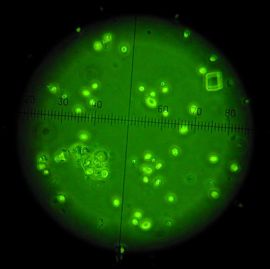
Microbiological analyses

Brettanomyces, pediococci, lactobacilli, acetic bacteria ....
there are many germs likely to cause a loss of your wine's organoleptic qualities.
Performed as a precaution, an analysis of alterating germs can detect them before they reach a population level detrimental to the quality of your wine.
It will then be possible to adjust your treatment to the detected level of contamination and avoid organoleptic deterioration of your wine.
ICV Group laboratories offer analytical solutions to control these situations
Did you know?
What are the main spoilage germs?
. Brettanomyces leads to the development of animal scents, stable, horse sweat, and increased aggressive taste (drought, bitterness in the mouth).
. Lactic acid bacteria is responsible for various changes such as grease, vinegar, mouse flavours or biogenic amines.
. Bacteria acetic results in acetic stings.
The risks associated with major wine contaminants:
. lactic sting: acetic and lactic smell, increase of volatile acidity
. bitterness
. biogenic amines: likely to cause allergic reactions, animal notes, dirty.
. geranium: Geranium leaf smell
. turn: cloudy wine, browning, smell lactic flat and soft taste (sauerkraut, sour)
. fat: oily consistency, shooting and viscous
. mouse Taste: acetamide called "mouse urine" smell
. the flower: yellowing and bland flavor
. acetic fermentation: acescence, increased volatile acidity
What are the main spoilage germs?
. Brettanomyces leads to the development of animal scents, stable, horse sweat, and increased aggressive taste (drought, bitterness in the mouth).
. Lactic acid bacteria is responsible for various changes such as grease, vinegar, mouse flavours or biogenic amines.
. Bacteria acetic results in acetic stings.
The risks associated with major wine contaminants:
. lactic sting: acetic and lactic smell, increase of volatile acidity
. bitterness
. biogenic amines: likely to cause allergic reactions, animal notes, dirty.
. geranium: Geranium leaf smell
. turn: cloudy wine, browning, smell lactic flat and soft taste (sauerkraut, sour)
. fat: oily consistency, shooting and viscous
. mouse Taste: acetamide called "mouse urine" smell
. the flower: yellowing and bland flavor
. acetic fermentation: acescence, increased volatile acidity


